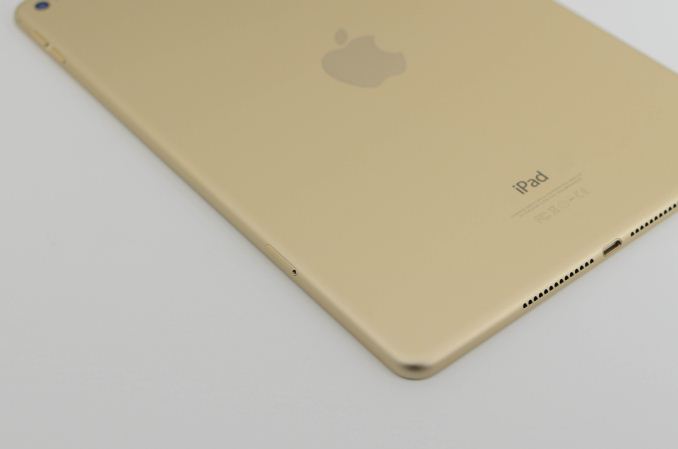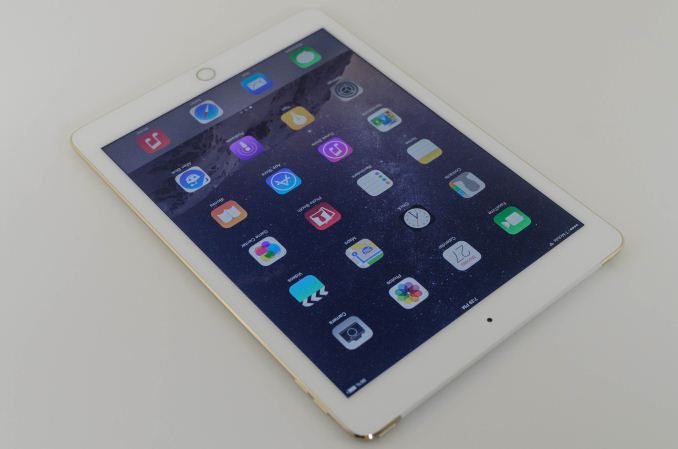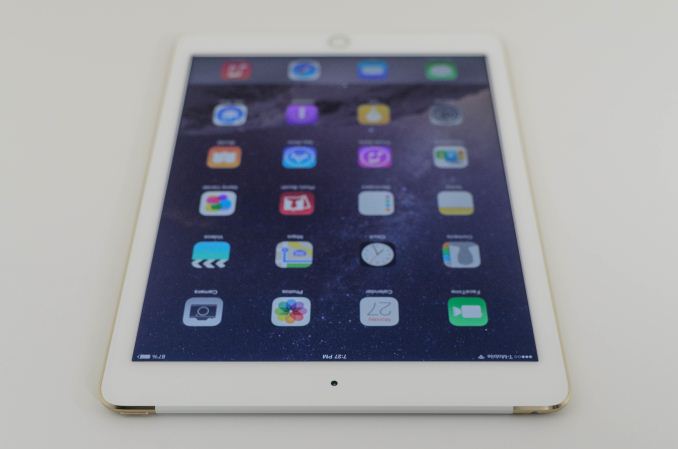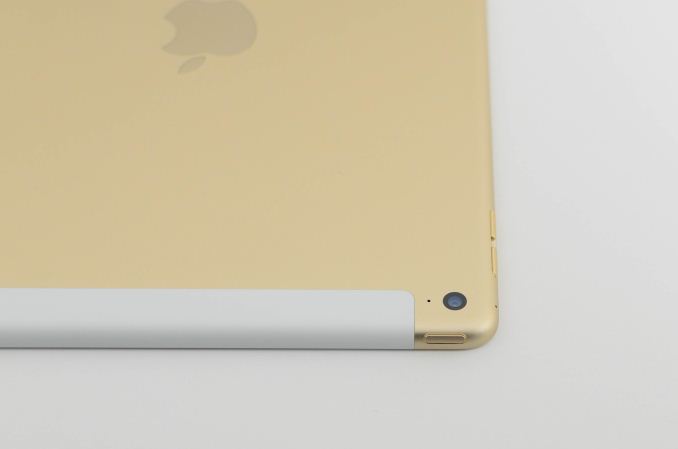The Apple iPad Air 2 Review
by Joshua Ho on November 7, 2014 9:30 AM EST- Posted in
- Tablets
- Apple
- Mobile
- iOS
- ipad Air 2
Final Words
Overall, there’s a lot to go over on the iPad Air 2. While the name suggests that it’s an iterative update in nature, in practice these updates add a lot of compelling hardware to the high-end iPad line. One of the first areas worth looking at here is the design. While not a radical shift from the iPad Air, the differences in design and the even thinner build helps to set the iPad Air 2 apart.
The next item of note is the A8X, which represents a return to dedicated SoCs for the iPad line. This is presumably done to preserve performance parity at native resolution for the iPhone and iPad line, and the extra CPU core is intriguing as it represents a shift away from the two CPU core system that Apple has stuck with for a while. In practice, this makes the iPad Air 2 one of the fastest ARM-based tablets on the market. Only NVIDIA’s Tegra K1 is able to compete with its GPU performance, and at the cost of greater heat and power consumption.
The next major point of note is the display. While not much has changed to the display itself, the surrounding components have seen a few upgrades that have been sorely needed for the past few years. The display is now laminated to the cover lens, which dramatically improves interactions with the device as the display feels much closer to the glass than before. The iPad Air 2 also has a custom anti-reflective coating on the display is really unlike anything else I’ve seen before as the frequencies reflected make the glass appear to be producing purple reflections. Despite keeping the tablet at 200 nits, I found that it was still fully possible to read the display outdoors during the day. There also seems to be some level of improved calibration, although the panel is mostly the same when judged by the appearance of the gamut and also the brightness/contrast numbers. At any rate, this display is more than capable of doing proper photo editing as the device is more than accurate enough for serious work.
Despite these upgrades and the smaller battery, in practice it seems that Apple has made good on their promise of generally unchanged battery life from the iPad Air. While there are phones and phablets out there with better battery life, I suspect that most will be more than happy with the battery life of the iPad Air 2. If one found battery life to be sufficient on a previous iPad, battery life on the iPad Air 2 should just be more of the same rather than any surprises. Apple also deserves some level of recognition for the incredible efficiency and sustained performance during this test as even the Tegra K1 can't quite do both.
There’s also the question of software, which continues to be class-leading on the iPad. While tablet applications that haven’t been properly scaled on the iPhone line are likely to look horrible due to the scaling factor used, this kind of experience is unlikely to occur due to the strength of the ecosystem at this point. While the same can and does happen with Android apps, it isn’t nearly as obvious because most of the scaling done is far more seamless and simply leaves a great deal of white space in the application that can’t necessarily be used.
As a result of all this work, it seems pretty obvious that the iPad Air 2 continues to deliver some of the best tablet software on the market. For the most part, every application available seems to effectively deliver a tablet-specific experience that helps to set the iPad lineup apart from other tablets. Unfortunately, it seems that due to a lack of competition there isn’t much in the way of attempts to dramatically improve the software experience, and as a result it’s a bit difficult for me to justify carrying a tablet around all the time as its size means I can't just put it in a pocket unlike a six-inch phablet.
However, there are still some notable new features, namely TouchID, which works incredibly well and leverages Apple’s tightly-meshed ecosystem to deliver a better experience than just about anything else on the market. Unfortunately, I’m not necessarily sold on TouchID on a tablet as an ergonomic ideal as the sheer width of the device makes it a bit harder than usual to properly place my finger for scanning. The functionality makes up for it though and TouchID remains one of the real killer features of Apple devices.
Finally, the camera is a nice step up from the iPad Air. While it may seem like an incremental step, a meaningful camera change to the iPad Air 2 is relatively surprising given that it hasn’t significantly changed since the iPad 3. It’s surprisingly competent in daytime, although at night a great deal more noise creeps in than one might expect from an iPhone 6 or similar device which has a larger sensor.
Overall, the iPad Air 2 is likely to be one of the only tablets worth buying on the market today. While iOS isn’t perfect, it’s definitely delivering the best tablet experience as its app support is second to none. While other OEMs may have more features, iOS manages to hold on by virtue of its superior polish and integration with Apple hardware. While I’d like to see Apple push the envelope further with the iPad line, it’s hard to argue this when other OEMs seem to be content with the status quo. While it’s likely that Apple will be able to hold on to its tablet lead, it remains to be seen if Google’s Nexus 9 can prove to be a viable competitor to the iPad Air 2.














226 Comments
View All Comments
name99 - Friday, November 7, 2014 - link
Roughly Haswell IPC is equal to Apple IPC. There are lots of caveats to this --- Apple does better on Geekbench, Intel does better on SPEC (probably because they have a superior memory system). Intel also have, to be fair, a much more mature compiler, while Apple can probably squeeze another 10% out of LLVM for ARM64 over the next year or two, along with some improvements to the SPEC numbers when their long awaited polyhedral optimizations finally go mainstream.I used to think Apple would ramp to higher frequencies, now I think a different trajectory is more likely. An Intel CPU is a bundle of many capabilities, and the CPU part is only one of these. There's also, for example, the turboing subsystem, and the profiling/debugging subsystem. My guess is that they are (even though they have said nothing about it) headed for the same sort of HSA future that AMD talks about.
I expect over the next few years, much Apple work will go into this sort of less than sexy infrastructure, stuff that Apple won't talk about much (if at all) and it will only make its appearance in things like better XCode tools and much less overhead to transfer code and data between CPU and GPU. Looking at the competitive landscape, Apple look like they could get away with an A9 improvement that's to the A8 as the A8 is to the A7 --- a steady 25%, one third from compiler, one third from another 100 or 150MHz boost, and one third from more tweaking of the CPU.
It's possible that this is indeed what we should expect because I'd guess that Apple's A-team for CPU design is hard at work on the AWatch project, and probably following the same strategy as we saw with CPUs --- the S1 will probably be a good but not spectacular SoC, something reliable to get the project rolling, the equivalent of A5. S2 will presumably be a substantial jump, with all the less risky optimizations they couldn't fit into S1, while S3 will knock it out of the park, taking the risk of project slippage to make use of every good idea the team has.
If this theory is correct, It may not be until A10 or so, as the team has hired more people and the watch project becomes more stable, that we get a rethinking of the phone/tablet CPU.
[Of course by then, who knows, maybe Apple will have announced iDust and mote CPUs will be what their CPU A-team are working on?]
anquietas - Friday, November 7, 2014 - link
Good perspective! This sounds lIke exactly how Apple would operate.iwod - Saturday, November 8, 2014 - link
This. Most people when comparing ARM64 SoC to Intel often fail to count the difference between the software ecosystem. Intel had much more engineers and years of optimization in libraries, and compiler. There are still quite lot of work to do on ARM64 and LLVM.JoshHo - Friday, November 7, 2014 - link
While we haven't included the Surface Pro 3 in comparisons as it's a much more expensive device, all of the tests in this review and more have been released to Bench where you can compare the two SoCs.ABR - Friday, November 7, 2014 - link
Just got back from checking the iPad Air at a store, and the performance was disappointing to say the least. I've got an iPad 2, and I keep reading about these leaps and bounds in the SOCs each year, but when it comes to a real-world task like opening the Mail app or paginating a novel in iBooks, this supposedly mind-blowingly smoking device is only incrementally faster than my 2nd gen clunker. What gives?I thought maybe everything was being bottlenecked by the flash access, but Josh tested that too and of course it looked way ahead of earlier hardware in that area too. iOS slowdowns? I'm running 7 instead of 8 on the Air 2, but that's only one generation behind.
Anyone have any idea what the deal is?
rUmX - Friday, November 7, 2014 - link
You need to be performing more intensive tasks to see the huge peperformance differences, as benchmarks show. Opening mail is not very demanding.ABR - Friday, November 7, 2014 - link
I guess you're saying maybe there's a floor effect with Mail opening given by the animation timers if nothing else, but how do you explain iBook pagination? That takes several seconds and seems to be computatin limited.Sushisamurai - Friday, November 7, 2014 - link
If u can't tell a difference, then maybe u should hold onto your iPad 2. I sold my iPad2-32GB wifi model for $200, just to upgrade to this Air 2. My iPad2 was stuttering and dropping frames for the apps I was using (also on iOS8). This Air 2 is absolutely amazing compared to the iPad2 - some of my daily apps can load, and reload (after downloading a minor update), before my other iPad2 finishes loading LOLABR - Saturday, November 8, 2014 - link
Maybe it's iOS 8 then. Good way to sell hardware. The big performance drop going to 7 is one of the reasons I'm not going any further yet. I'd get the Air 2 for the weight, retina, and fingerprint, not the SOC, but the way it runs hot is a big downgrade.Streamlined - Friday, November 7, 2014 - link
FYI, I was doing some financial analysis on Apple and the iPad Air 2 cost structure and I'm estimating that the "Apple Tax" on these is probably only a little more than $100 per unit on the 16gb wifi model.Read the details at www.perezonomics.com